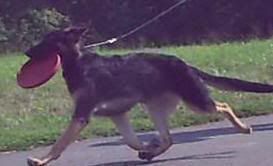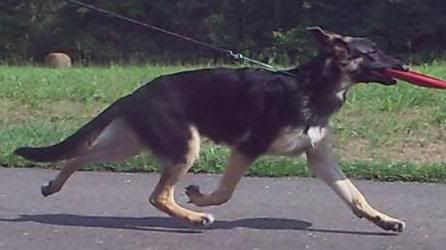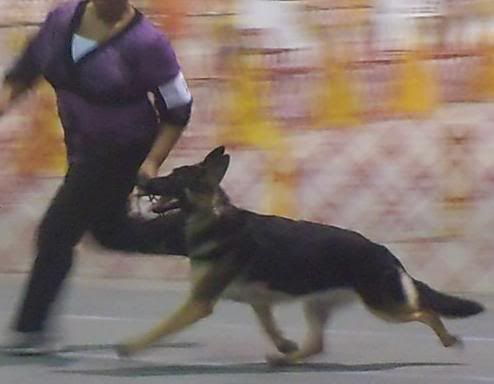
This is a placeholder text
Group text
by Xeph on 23 October 2011 - 15:10
I show my bitch on a loose lead (She's on leash in that gaiting shot, but it's a still from the video, so the graininess makes it hard to see the leash). I actually show with the collar up behind the ears so she DOESN'T choke (and so collars don't break...I don't like to use chunky fursavers much), and for better control on the go around when she follows (on the dead ring). It also just presents a nicer picture, and doesn't break the neck line of the dog.
When she stacks, she picks her head up because I'm baiting her. She wants food. And American judges want the dogs looking up and alert. Dogs that drop their heads to low while stacking look like they have a flat wither, and are bored. It also causes them to look front heavy. It's not a pretty picture.
My hand is rather closer to her head in the pictures not because I'm holding her head up, but because I'm holding the chain she's wearing. You want to see as little of the choke chain as possible, and so the excess gets wrapped up in the hand while being held behind the ears.
These are old photos taken when she was stilll learning how to gait on lead. The collar is up behind her ears, but she's not being choked. It's all about presentation.

The collar slipped lower here, and I got a dog that gagged and wheezed

On the go around at a specialty

A dog that gaits with their head lower than their withers looks not so great. Forward carriage is preferred (yes, even in the AKC ring, believe it or not), and what I try to teach. I do not string up my dogs not because they go hackney (that is a completely different style of movement) but because they go lifty, and their fronts go all over the place.
by Rass on 26 October 2011 - 16:10
When taking a photo of a stacked dog you need to have a clear understanding of what the transfer of a 3 dimensional object onto a 2 dimensional surface will do.
In the photo of Xeph's bitch in the field with the deep grass, the depth of the surface hides what IMO are weak pasterns. It also makes the dog appear a bit more solid than she is.
If you take the photo from a high angle (I have seen so many "professionals" do this with dogs) then you will make the legs appear shorter and the body thicker because you get fore shortening of the legs and a portion of the back in the photo. This can help a whispy, long legged dog appear shorter legged and more substantive. A photo taken at dog level opposite the scapula can mkae the front of a dog seem more substantive and the rear less so. A photo taken at dog level opposite the hip can increase the appearance of substance in the rear and make the front less heavy.
So... while Stacks can creat different looks, the placement of the camera and the surface the dog stands on can create different looks.
You will notice that most Urma photos the dog is against a blanket of short, level cut, green grass. There is nothing else in the background. This allows the dog, and only the dog, to be the subject and helps to eliminate any optical illusions that can be created by the location of any horizon lines or background objects. You can vastly change the look of the dog and its stack by use of the back ground.
You can also create different images by placing the dog on uneven ground.
Soo.... there is a lot more to stacking and photographing the stack than has been covered even here.
There is a saying that photos of people add 5 pounds (or more) to the look of the person. If the photographer understands the business of taking a 3-D object and putting it on a 2-D surface, they will also understand how to take the image (camera angle to the subject) to either add or subtract substance, weight and so forth and either enhance to look of the subject or.. detract.......
And after all that there is understanding light and fill flash and how to use it to improve or detract from the subject look.
To stack and photograph a dog well, you need to know the dog's weaknesses and strengths and how to show one and reduce the appearance of the other.
by Xeph on 26 October 2011 - 21:10
Yup, it does...though I will say that's not what we were going for. My husband gets down on the dog's level for all photos, because that is what we were taught. The photo in the field is my favorite of my bitch, just because it's a pretty photo.
by Ibrahim on 27 October 2011 - 08:10
by Rass on 27 October 2011 - 13:10
by Xeph on 27 October 2011 - 15:10
And the insight was fab ^_^
by SitasMom on 07 November 2011 - 23:11
by bazza on 08 November 2011 - 10:11
by Preston on 11 November 2011 - 08:11
Folks may not realize that a properly constructed GSD will tend to walk naturally into an attractive stack off of the end of the lead and will often normally stand this way when on a lead. In most cases only very minor adjustments of a few inches are made by professional handlers in the SV, but this should never be necessary if the dog is built right and experienced in the showring (these can be done with the handler's foot while standing via soft pressure). GSDs that are not true to the standard will not set themselves up correctly, that is they will not walk into it. Professsional handlers, especially in the AKC or GSDCA American showrings work hard to make GSDs look and perform much better than they are, many times obtaining championships in unworthy dogs that are far too long with steep croups and pushed forward fronts with little prosturnum. Running them on a tight lead, stringing them up can cover many flaws in construction and movement (and length helps dampen imbalances but is inefficient). Manipulating the stack can compensate for east west issues. Lifting the head and stressing the neck can often cover mild undershot problems, etc. The cure for all this is an honest, non-political judge who runs the dogs loose lead (they do it off lead at the SV shows and this shows many weaknesses and faults of construction and movement but fast loose lead is even better). The best judges care more about how good the dog actually is, rather than how skilled or tricky the handler is.
There are many tricks and skills used by the few top AKC handlers of GSDs and they can do a great deal to cover up faults. But IMO it is better to go back to the way it was many years ago when many folks handled their own good dogs. There is nothing like a good honest, well constructed GSD with good balanced, adequate movement and proper proportions, and of course the most important trait, correct working temperament. Extremes may fool many, but they detract from the breed. That's why I believe that the SV GSDs of the 1960-1980's were the best, especially before the breed became bifurcated into zuchtscahu and profung. It has always fascinated me how both types used to come from the same kennels and sometimes the same litters. There were some cross-over GSDs that competed in both venues and did well, truly amazing. Frei Gugge for one was an exceptional producer in his own right.
by bazza on 11 November 2011 - 10:11
Contact information Disclaimer Privacy Statement Copyright Information Terms of Service Cookie policy ↑ Back to top




